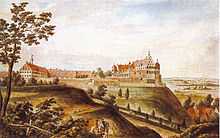Schloss Warthausen



Schloss Warthausen (Warthausen palace) is a schloss (large country palace) near the town of Warthausen in Germany. It has been home to several famous historical personages, including authors Christoph Martin Wieland and Sophie von La Roche, and painter Johann Heinrich Tischbein.[1] It was the traditional home of the Counts of Stadion-Warthausen. It is the subject of an article, The Gardens at Schloss Warthausen and Their Place in German Literature.[2]
History
In 1168, a castle was sold to Friedrich Barbarossa, and passed to the House of Habsburg in 1339.[3] The castle burned down in 1474, and was rebuilt.[2]
In 1529, Reichsritter Dr. Hans Schad von Mittelbiberach (1505-1571) [4] received the building from the House of Habsburg, adding new construction to it between 1532 and 1540, enlarging it to a country palace. It was burned again in 1623, during the Thirty Years' War, and rebuilt in the Renaissance style in the 1620s.[2]
From 1696 to 1827, Schloss Warthausen was in the possession of the Counts of Stadion.[5] The State of Württemberg took possession of it and its hereditary rights in 1827. In 1829, it was acquired by Wilhelm von König-Warthausen .[3]
It has been home to many notable historical personages, including Count Anton Heinrich Friedrich von Stadion , Johann Philipp Stadion, Count von Warthausen, Christoph Martin Wieland,[6] Johann Heinrich Tischbein, Sophie von La Roche,[1] and Friedrich Karl von Koenig-Warthausen.[2]
Since 1985, the building and its surrounding lands have been owned by Franz Freiherr von Ulm zu Erbach.[2]
Description
The palace is built in the South German Renaissance style. It has Baroque external architecture features. It is located just north of Warthausen, near the river Riss. It dominates the area and the eastern tip of the estate overlooks the Riss valley.[2]
The landscape as it had recently been completely redone in English style appears in a plan of 1793 by the gardener Brückner.[7] This new landscape design set a historic new standard for German gardens. The landscaped portion of the entire 120 acre estate consists of about 17 acres. It contains parterres (formal gardens). The remaining land is neatly divided in fields lined by allées, some being there still. There are some ornamental ponds and lakes on the estate.[2]
The Warthausen Brewery, active from 1632-1970, was located at the foot of the hill. It was a beer supplier for about 400 inns throughout Southern Germany and at tourist attractions. The building is now a nursing home.[8]
The estate has been a setting of inspiration for notable writers and poets who were invited to the property from time to time over the years. Wieland, a leading authority of the German Rococo, for example was inspired by the grounds of the estate. Wilhelm von König-Warthausen gave detailed descriptions of the Schloss and its gardens in his works.[2]
Coordinates: 48°7′51″N 9°47′34″E / 48.13083°N 9.79278°E
References
- ↑ 1.0 1.1 "Sehenswürdigkeiten". Gemeinde Warthausen. Retrieved 2014-06-05.
- ↑ 2.0 2.1 2.2 2.3 2.4 2.5 2.6 2.7 Head, David (1976). "The Gardens at Schloss Warthausen and Their Place in German Literature". Garden History 4 (2): 30–42. JSTOR 1586400. Retrieved 2014-06-05.
- ↑ 3.0 3.1 "Sehenswertes - Informationen zum Schloss Warthausen". www.city-map.de (in German). Retrieved 2014-06-05.
- ↑ "Süddeutsche Patrizier". RootsWeb's WorldConnect Project (in German). 2007-10-31. Retrieved 2014-06-05.
- ↑ "Herzlich willkommen auf dem virtuellen Marktplatz von Warthausen" (in German). Retrieved 2014-06-05.
- ↑ "Historisches – Kurzbiographie unserer Schule". Wieland-Gymnasium Biberach (in German). Retrieved 2014-06-05.
- ↑ D. Head, "The Gardens at Schloss Warthausen and Their Place in German Literature", Garden History, 1976.
- ↑ "Schloss Warthausen". Geschichte und Sehenswürdigkeit in Oberschwaben, Oberschwaben & Bad Waldsee Portal. 2012-11-25. Retrieved 2014-06-05.
- "Schloss Warthausen". Wikimapia. Retrieved 2014-06-05.
- Uhl, Stefan (1992). Schloss Warthausen: Baugeschichte und Stellung im Schlossbau der Renaissance in Schwaben (in German). Bad Buchau: Federsee-Verlag. ISBN 9783925171246.